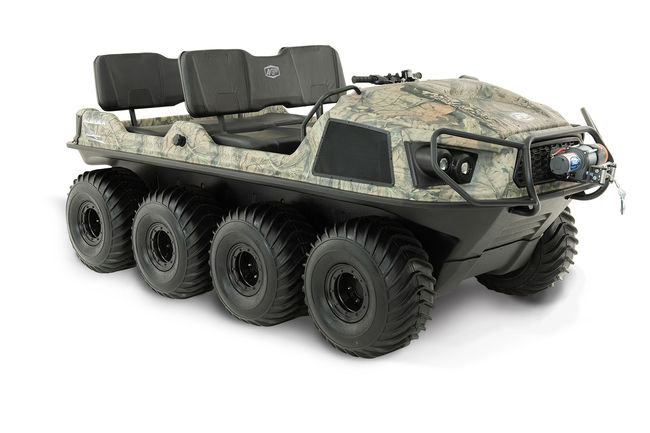How Does My Argo’s Transmission Work?

Skid steering? Steering brakes? All-wheel drive that works on pavement? If you’re new to Argo’s amphibious ATVs, they can be confusing. Here’s how Argo’s transmissions both move and steer their vehicles.
CVT with Selectable Final Drive
If you’re familiar with UTVs, this transmission will be familiar. The CVT works by using a V-shaped belt wrapped around a cone-shaped pulley on the input and a variator on the output. The variator uses a combination of spring pressure and weights to open and close as centrifugal weight acts on them. At low speeds, the variator is pushed in. This forces the belt to wrap around the outside edge of the variator’s sheaves and the inside edge of the pulley’s sheaves. Speed up, and the variator opens, swapping the position of the belt, raising the gear ratio and increasing vehicle speed.
Steering Brakes
To turn a vehicle with a skid steer system, the inner wheels need to spin slower than the outer wheels. This causes the outside wheels of the vehicle to overtake the inside, changing the vehicle’s position. An Argo does this with steering brakes.
The left and right drivelines each have their own steering brake. Turning the handlebar actuates a hydraulic master cylinder, pushing fluid into the caliper on the brake. Turning the bar left actuates the cylinder connected to the left brake, and turning it right actuates the cylinder connected to the right brake.
These brakes are inboard of the final drive. That means the final drive ratio determines how effective the brakes are at slowing the wheels. In high gear, the output shafts rotate fast, reducing braking power for smooth, gradual steering input. In low gear, it takes less force to stop the slowly spinning axles, resulting in faster steering response in low gear. Standard transmissions apply full braking force when steering, while the Admiral transmission can apply gradual force for precision turns.
Dual Differentials: A New Twist Skid Steering
Your car’s differential sends power through a spider gear before turning the axles. This gear is bolted to the ring gear and spins with it. If the vehicle is traveling straight, the spider gear doesn’t turn. Instead, its teeth push both shaft gears at equal speeds.
When making a turn, the inside wheels need to travel slower than the outside wheels. The spider gear spins, letting the inside move less and the outside move more. This always follows an equivalent ratio. If the axles each pass 10 teeth to go a certain distance when moving straight, that’s a total of 20 teeth. When making a turn, if one side spins past 5 teeth, the other side must spin past 15 teeth.
Argo’s transmissions have two differentials, one for each side of the vehicle. This completely separates the two drivelines. If one side stops moving, as it would in a sharp turn, the other side doesn’t have to spin twice as fast. This lets one side stop completely without doubling the speed of the other side. The result is less scrubbing and better control.
APS
APS, which is standard on the new Aurora, adds a spring system to the handlebars. This adds resistance to steering and returns the handlebar to neutral automatically. The result is steering feel more like an ATV. It also prevents drivers from accidentally engaging one of the steering brakes. While light application might not be enough to steer the vehicle, the friction can cause the brake to overheat.
Full Time All Wheel Drive
In other off-road vehicles, locking the differentials causes handling problems. With all wheels turning at the same rate, the inner wheels have to scrub against the surface to make up for the decrease in distance relative to the outside wheels. This can cause them to break traction on a soft surface. On pavement, steering will get heavy and the turn will go wide up until the tires can break free.
The output shafts are permanently connected to the wheels using a pair of chains, but it doesn’t have the handling problems of other off-roaders thanks to its differentials and tires. Even with every wheel getting power, the inside and outside wheels can turn at different rates. By using giant tires, weight is spread out, keeping them from digging in and releasing their grip like a standard-size wheel. The result is consistent handling on all surfaces without disengaging all-wheel drive or locking differentials.
Shank’s is Your Source for Everything Argo
Shank’s Argo doesn’t just sell Argo XTVs, we’re one of the largest dealers in the East, and we have over three decades of experience with outdoor equipment. We can help you find the right model for your needs and provide the parts and service you need to keep it running. Visit our showroom at 4900 Molly Pitcher Highway in Chambersburg, PA. We’re just one mile from I-81. To schedule a demo in person, go to www.shanksargo.com.
